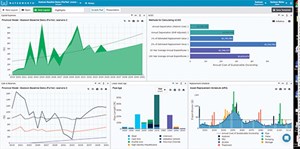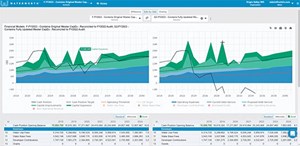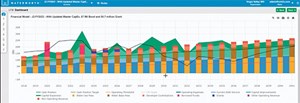April 2023 Vol. 78 No. 4
Features
Cloud platform gives communities control over their revenue management destiny
(UI) — When the effects of rampant inflation became apparent in Nevada’s Virgin Valley Water District in 2022, a tank installation project budgeted for $2.4 million – similar to a $2-million-project completed in 2018 – received a bid of $3.6 million. So Chief Financial Officer Wes Smith set to work recalculating the projected cost of planned capital projects.

When he plugged the numbers into a Waterworth forecasting model, the result showed the district would be bankrupt by 2027.
Smith took the forecasted scenario to the district’s board of directors, proposing a $7 million bond, and a rate increase, which changed the model’s prediction to show a healthy cash position until nearly 2029.
“A $7-million bond bought me essentially seven years to get a rate increase through and get some changes made,” Smith said.
Board members approved the bond in 10 minutes.
“They had a couple of questions, but because they’re so comfortable with Waterworth, when I was able to show them the pictures, they said, ‘If that’s what we need to do, let’s do it,’” Smith said.
Unique solutions
Waterworth is a cloud-based platform designed for continuous utility rates management and forecasting, said JP Joly, founder and CEO of the company. It’s incredibly unusual for such a decision to be made so quickly, and that’s at the heart of continuous utility rates management, he said.
“The math doesn’t lie,” Joly said. “Because Wes had taken the time to keep his board members familiar so they know and trust the model the moment they saw what needed to be done, it was a no-brainer for them.”
Joly began doing rate studies in the water utility business about 18 years ago. Originally, it involved using Microsoft Excel, which was not a workable solution to sharing models, and writing a “very long, boring” report that quickly became outdated, he said.

“That got me thinking; ‘There’s got to be a better way to do this.’ The idea was to put all of that expertise and know-how onto the cloud, like everything else is,” Joly commented.
Created in 2016, Waterworth gives clients more control over revenue management and forecasting by logging in to the platform and adding data to create hypothetical scenarios, without having to engage with outside consultants. Additionally, the software uses a lot of interactive visuals to help guide decision-making – a refreshing change from long documents full of “walls” of numbers, he said.
Waterworth’s website indicates that while it’s capable of handling data for even the largest metropolitan areas, the company’s focus is on smaller municipalities, which may not have access to the same funding and resources as bigger cities.
Regarding pricing, Joly commented that a yearly Waterworth subscription, is a fraction of the cost of a traditional rate study. It can also provide the needed information much more quickly.
“By comparison, the last time I had a rate increase and used an outside consultant it cost almost $100,000 and took nine months for us to hear back about what we needed to do,” Smith said. “By then, things had changed.”
With Waterworth, Smith can plug in numbers to the model right when anything changes away and see potential effects in the short and long term.
“I could not function, frankly, without Waterworth, in terms of my financial role,” Smith said. “It has made my job so much easier, and allows the board to make decisions based on the way things are.
“Our board has grown to depend on it. When we have decisions to make, the standard request is, ‘What does Waterworth look like?’”

Financial challenge
When Smith joined the district in 2011, it was “financially challenged,” he said.
Just before his arrival, a 36-percent rate increase had been implemented across the board, and when that wasn’t enough to make the district financially sustainable, a 42-percent increase followed.
“The public was screaming bloody murder with huge increases like that,” he said.
Smith estimates between 125 and 150 people attended the board meeting at the time of the 42-percent increase, in 2015. Virgin Valley, which has a service population of about 25,000 – and growing – is now in its third cycle of implementing three-year rate increases using the Waterworth model. The most-recent board meetings have had less than five members of the public attend.
“The ones that came stood up essentially to say, ‘We appreciate you taking a proactive approach, doing small incremental increases and being prudent about this,’” Smith said.
The model can grow and evolve over time, factoring in additional data as needed, to help clients closely examine rates and make necessary changes little by little.
“This is a long-term game,” Joly said. “For some communities it’ll take a generation to correct things.”
Implementing the cloud system involves an initial meeting during which a client’s financial data is collected to create a baseline model. From there, the focus is helping with quick wins by exploring different scenarios and putting together a story about achieving the highest priorities that can be taken to decision makers.
Throughout the process, there is on interactive partnership and engaging with clients periodically, Joly said.
“At the end of the day, these communities need more than just a tool; they need some strategic oversight to know how to think through this, and how to communicate the issues in a way their stakeholders can understand and buy-in to and then make the decisions,” Joly said.
“I like to tell our clients, ‘We’re mathematicians, first and foremost, and secondly we’re communicators.’ We’re really good at storytelling and helping people get it.”
Waterworth has worked with 120 communities already and continues to grow, with plans to focus on helping even smaller communities, once it’s more established in the medium-sized segment of the market. A sister service, Muniworth, is also available to assist clients with additional areas, including gas and electric, recycling, airport and marina, roads, general fund and more.
As with any process or technology change, it can be difficult for people who have been doing things the same way for decades to imagine a better way, Joly said.
Smith agrees. He was a “little bit nervous” when first changing to the new software.
“It can be a little bit scary or daunting,” he recalls. “But Waterworth makes it real easy, and in my estimation, it’s worth a look for an entity to be in control of its own destiny.”
FOR MORE INFORMATION:
Waterworth, (844) 349-2837, waterworth.net




Comments